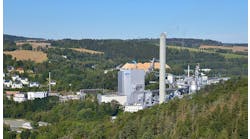The owners of an average small- to mid-sized industrial facility could save 10% on their power bill and $42,000 annually by auditing energy use and implementing recommendations to upgrade equipment and change operations, according to data from a U.S. Department of Energy program.
University professors and students in 24 locations across the United States are involved in the Industrial Assessments Centers (IACs). Data from those centers, the results of more than 16,000 on-site industrial assessments, suggest such significant savings, or even greater, are possible depending on the type of manufacturing facility.
For years, industrial and commercial facilities viewed their electrical utility bill as the cost of doing business. Then, those energy costs began to spike as fossil fuel costs rose to unprecedented heights – more than $100 per barrel in the case of oil. Concurrently, energy efficiency technology innovations that deliver energy savings with no sacrifice in performance (and sometimes improves in product quality, production rate, safety, etc.) accelerated in development.
Also read: Energy Consumption Visibility Is First Step to Savings
Even though oil prices have settled, the surge of interest in energy retrofits remains unabated as governments and environmentally conscious companies look to curb greenhouse gases blamed for climate change and utilities seek to extend the capacity of existing power-generation plants. And of course the specter of higher fuel costs looms in the future.
New source of profit
Indeed, American facilities have found a potential new source of profit margin by becoming more efficient by cutting their monthly energy bills.
The U.S. government's Department of Energy has set up programs to help industrial companies curb energy costs and thus greenhouse gases. One of those, completes in-depth assessments on plant operation in order to identify energy efficiency improvements, minimize waste and pollution and improve productivity. The IACs compile the data for their assessment for use by industry in a database accessible online.
Users can glean valuable information from the database by approximating potential electrical and natural gas energy savings by taking a look at the average results obtained at similar industrial plants. The database also lets user identify frequently recommended efficiency measures for each industrial plant.
Another energy savings estimate tool is the Plant Energy Profiler, into which a user inputs annual energy use and cost data as well as a breakout of energy use by operating process or system in a given plant. A default breakout of energy use by production process is offered in the absence of the specific data. (Learn more here.)
Beyond the federal government programs, local utilities have launched customer service campaigns aimed at assisting facility manager to make better use of the power they are consuming.
Why do this? Utilities have capacity concerns and it's easier to curb waste than it is to build power plants. Even getting a new power plant approved through the tangled regulatory framework can take years. And the random oil spill or nuclear plant disaster show just how limited the options are for generating new power.
Thus, electrical utilities have a keen interest in avoiding having to add to their existing generation capacity. And facility managers have incentives to reduce power waste and become more efficient. If a company's profit margin is 5%, saving $30,000 in energy costs equates to sales of $600,000, and many energy-savings measures may have simple payback of several years or less.
"Energy studies are essential for identifying opportunities for energy saving measures with proven returns on investments," said Rob Penney, senior energy engineer at Washington State University's Energy Program. "If you can't measure it, you can't manage it. Take advantage of the excellent audit tools and on-line information resources available to ensure cost-effective success."
Energy audit basics
A basic energy audit can help determine which operational function consumes the most energy per month.Many facilities have identified the easy targets – energy consumption that can be decreased without substantial investment as well as to take advantage of government energy-efficiency subsidies.
Common examples
- Shutting off equipment and systems overnight instead of leaving them on
- Upgrading lighting systems to more energy efficient LED banks and motion sensors switches.
- Upgrading chillers to high-efficiency models
- Fixing leaks in compressed air lines
- Adding controls to match mechanical equipment output to performance requirements
Also read: Trim Your Power Bill by 10% or More
For more effective energy savings, it's best to take a systems approach. Rather than replacing a component with something similar, start with end uses, then look at distribution systems, and finally look at the central plant. For a compressed air system, this would mean reconsidering wasteful end uses (such as sweeping the floor—get a broom!), then fixing distribution leaks, and finally considering a more efficient compressor, which may now be sized smaller than the previous equipment.
Add to those examples yet another major concern that can hit facility manager's bottom line – dirty power.
Energy engineers have known for many years that imperfections in the purity of power – such as harmonic distortion and load unbalance -- caused three-phase equipment performance issues. And in the case of power factor diminished the usability of the distributed electricity. Utility companies sometimes even charge for excessive power factor.
But it was only a decade ago the IEEE along with academics sought to quantify the amount of power made unusable by such imperfections.
In two studies, one at an automobile plant and another at an industrial park, Professors Vincente Leon and Joaquín Montañana at the University of Valencia in Spain were able to quantify annual energy savings from power quality adjustments.
In the industrial park example, the utility was able to save $14,000 a year by installing time-control relays to disconnect a capacitor bank at night; and the automobile plant upgraded transformers and installed capacitors and regulator controls for a savings of $50,000.
Hailed as a breakthrough, their Unified Power measurement took recommendation of the IEEE1459-2000 standard that defined the sources of specific wastes and calculated the energy wastes of reactive power, harmonics and unbalance in the electrical system.
Fluke learned of the breakthrough and approached the two professors about a partnership. The result:Fluke engineers were able to transition the science from academic research into Unified Power measurement feature and an Energy Loss Calculator that is now available in portable handheld power quality analyzers. Both parties hold patents on different aspects of the new capability.
Quantify energy waste
Handheld energy analyzers, such as the Fluke 1730 Three-Phase Electrical Energy Logger and Fluke1738 Three-Phase Power Logger, deploy Unified Power measurement calculations to express power and energy data that directly quantify the waste energy in electrical system by measuring harmonics and unbalance waste in terms of kilowatts. The measurements also factor the cost of each kilowatt hour to calculate the cost of waste energy over a week, a month or a year.
Armed with handheld energy analyzers, engineers or electricians can log the energy to equipment known to consume large quantities of power, then quantify the savings to make a case to manager for improvements in their plants.
Some of those recommendations might include adding capacitor banks to resolve power factor issues, or changing the type of electronic equipment. And in the case of unbalance, installing unbalance compensation equipment or increasing the over electrical distribution system capacity. Even the installation of a harmonic filter will improve overall power quality and increase both equipment reliability, efficiency and lifespan and decrease downtime.
Also read: Plants Find Powerful Ways to Boost Energy Efficiency
But with the new Unified Power capability, coming up with the cost of labor and equipment necessary to mitigate harmonics and unbalance as compared to the amount of energy wasted, becomes a relatively straightforward ROI equation.
And once the changes are implemented, a routine of monitoring equipment with the handheld analyzers can be a way of ensuring smooth and efficient operations.With new tools – such as handheld energy analyzers -- and resources available only justifying the costs of upgrades and improvements at the facility are easier than ever
Top 10 Recommendations for Energy Savings (all industry)
- Utilize higher efficiency lamps and/or ballasts
- Eliminate leaks in inert gas and compressed air lines
- Use most efficient type of electrical motors
- Install compressor air intakes in coolest locations
- Reduce the pressure of compressed air to the minimum required
- Utilize energy efficient belts and other improved mechanisms
- Install occupancy sensors
- Use more efficient light source
- Insulate bare equipment
- Analyze Flue gas for proper air/fuel ratio
Source: US DOE, IAC Database, 1981-2015
Source: US DOE, IAC Database (Recommendations Per Assessment), 1981-2015
Top 10 Recommendations for Energy Savings in Chemical Manufacturing (NAICS 325)
- Install equipment to utilize waste fuel
- Repair and eliminate steam leaks
- Use waste heat to produce steam to drive a steam turbine generator
- Establish burner maintenance schedule for boilers
- Increase the amount of condensate returned
- Operate boilers on high fire setting
- Install equipment (eg compactor) to reduce disposal costs
- Use steam pressure to generate power
- Recover waste heat from equipment
- Use a fossil fuel engine to cogenerate electricity or motive power, and utilize heat




